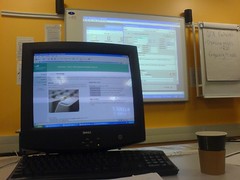I think we're all agreed that we need a new Content Management System, but we need to make sure we get the right one. Here's a summary of what our basic requirements might be. This isn't entirely my own work, I hasten to add. It's based on example requirements from elsewhere, but I think it provides a useful starting point. I'd be very interested in what you think.
The CMS must be an established system, with demonstrable market presence, from a financially stable provider. It must provide a single repository for the storage of information, and enforce the separation of content from design. It must be easy to use and cater for a cross section of skills, and should improve the speed of creating new content and editing existing content. The system must be able to run both our public-facing external website and our internal intranet, with reliable security measures and system contingency. It should be easy to extend or customise the software, and develop into other web service areas, such as discussion threads and online form design. It should be possible for the system to interact with other software in industry-standard formats such as XML and RSS. Technical support must be available from the supplier.
The system must enable decentralised management of content to avoid authorisation bottlenecks, be accessible 'outside the office', and must have the ability to manage users and administrators efficiently, incorporating role-based security and group profiling. A full audit trail of content authors' activities must be available. A workflow model must be in place, with clear content approval processes.
The output of the CMS must conform to accessibility and disability standards, without requiring content contributors to have any technical (e.g. HTML) knowledge in this area. The system must provide the ability to publish content to a variety of channels, including mobile devices, as well as text only. It must enable the incorporation of multimedia content and be capable of displaying content 'dynamically' so that pages can appear fresh and different each day. The system should incorporate a link-checking mechanism, and links within the site should not be broken if a page is moved or renamed.
The CMS should publish pages with human-readable URLs and have an automatic, customisable sitemap capability. Site navigation must be easy to maintain, and should preferably automatically reflect changes to the site. The CMS should provide conversion and publication of MS Word, Excel, PowerPoint and PDF documents, and should preferably have tools to enable the migration of content from our legacy CMS.
CMS administrators and authors must not need to have proprietary software skills (e.g. HTML, JavaScript, ASP etc), but it should be possible for advanced users to take advantage of their extra skills. The system must have a WYSIWYG style content preview function, and enable users to add images easily from a 'library' of acceptable images.
The CMS must have version control functionality, allowing users to view versions of published content, subject to permissions. When approving a new version, it should be easy to determine how the current and the new versions differ. Roll back and roll forward functionality should exist, that retains the integrity of the version history.
It should be possible to create secure areas of the site that only some site users can access, and a full audit trail must exist for both content and users. The CMS should provide a visitor statistics facility and a search facility.
